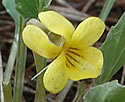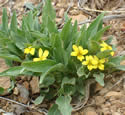Viola nuttallii (Yellow Prairie Violet)
| Also known as: | Nuttall's Violet |
|---|---|
| Genus: | Viola |
| Family: | Violaceae (Violet) |
| Life cycle: | perennial |
| Origin: | native |
| Status: |
|
| Habitat: | sun; dry, sandy, gravelly soil; prairies |
| Bloom season: | April - May |
| Plant height: | 2 to 4 inches |
| Wetland Indicator Status: | none |
| MN county distribution (click map to enlarge): |  |
| National distribution (click map to enlarge): |  |
Pick an image for a larger view. See the glossary for icon descriptions.
Detailed Information
Flower: 

![[photo of flower]](/udata/r9ndp23q/yellow/viola-nuttallii-yellow-prairie-violet_0508_093018-t.jpg) Irregular 5-petaled yellow flower about ½ inch (to 15 mm) long at the end of minutely hairy stalk held among the leaves at peak bloom. The 2 lateral petals have small tufts of short yellow hairs at the base (bearded). The lower petal has dark purple veins radiating from the center and forms a short spur at the back.
Irregular 5-petaled yellow flower about ½ inch (to 15 mm) long at the end of minutely hairy stalk held among the leaves at peak bloom. The 2 lateral petals have small tufts of short yellow hairs at the base (bearded). The lower petal has dark purple veins radiating from the center and forms a short spur at the back.
![[photo of sepals, spur and back of petals]](/udata/r9ndp23q/pd/viola-nuttallii-516-15-t.jpg) The backs of the petals are often tinged purple, especially the 2 upper petals. Sepals are lance-linear, pointed at the tip, and hairless or minutely hairy.
The backs of the petals are often tinged purple, especially the 2 upper petals. Sepals are lance-linear, pointed at the tip, and hairless or minutely hairy.
Leaves and stems: 


![[photo of leaves]](/udata/r9ndp23q/yellow/yellow-prairie-violet_0418_102852-t.jpg) There are both stem leaves and basal leaves, though they may all appear to be basal; color is gray-green. Mature leaves are up to about 2 inches (to 53 mm) long, usually at least 3 times as long as wide, mostly lance-shaped or lance-linear, blunt to pointed at the tip, tapering at the base. Leaf edges are minutely fringed and toothless or have a few shallow teeth near the tip; surfaces are minutely hairy. Leaf stalks are minutely hairy.
There are both stem leaves and basal leaves, though they may all appear to be basal; color is gray-green. Mature leaves are up to about 2 inches (to 53 mm) long, usually at least 3 times as long as wide, mostly lance-shaped or lance-linear, blunt to pointed at the tip, tapering at the base. Leaf edges are minutely fringed and toothless or have a few shallow teeth near the tip; surfaces are minutely hairy. Leaf stalks are minutely hairy.
Fruit: 
![[photo of developing fruit]](/udata/r9ndp23q/pd/viola-nuttallii-516-13-t.jpg) Fruit is a capsule up to about 1/3 inch long (6 to 9 mm), initially green and nodding, becoming erect as it matures, drying tan, and splitting into 3 sections at maturity. Inside are many brown seeds about 3 mm long.
Fruit is a capsule up to about 1/3 inch long (6 to 9 mm), initially green and nodding, becoming erect as it matures, drying tan, and splitting into 3 sections at maturity. Inside are many brown seeds about 3 mm long.
Notes:
One of two yellow violets in Minnesota, this rare species is found on prairie moraines while Downy Yellow Violet (Viola pubescens) is a common woodland species. According to the DNR, Yellow Prairie Violet was first discovered in Minnesota in 1981, not that long ago, and classified as a Threatened species in 1996 due to its rarity in the state. Its preferred habitat is also the preferred type of site for gravel mining and/or grazing, which puts the species at risk. When we went in search of it ourselves, we were disappointed to find most of the sites where it had been previously found were no longer there—they had all been turned to pasture or industrialized with nary a native species left. Luckily the DNR had the foresight to snatch up some land in western Lac Qui Parle county where this little gem still has a chance to thrive.
Native Plant Nurseries, Restoration and Landscaping Services ↓
More photos
 Yellow Prairie Violet plant
Yellow Prairie Violet plant Yellow Prairie Violet plant
Yellow Prairie Violet plant Yellow Prairie Violet plant
Yellow Prairie Violet plant Yellow Prairie Violet habitat
Yellow Prairie Violet habitat
Photos by K. Chayka and Peter M. Dziuk taken in Lac Qui Parle County and in South Dakota. Photos by John Thayer taken in North Dakota.
Comments
Have you seen this plant in Minnesota, or have any other comments about it?
on: 2014-05-20 18:10:32
Found this beautiful flower today in nature park. Where can I submit a photo of it?
on: 2014-05-20 19:17:42
Janie, you would not have found Viola nuttallii in Washington County because it is a rare species only known to be in a few locations in 3 western counties. What you saw was the other yellow violet, Viola pubescens. Notice the leaves are quite different, as is the woodland habitat.
You can post pictures on our Facebook page if you like.






